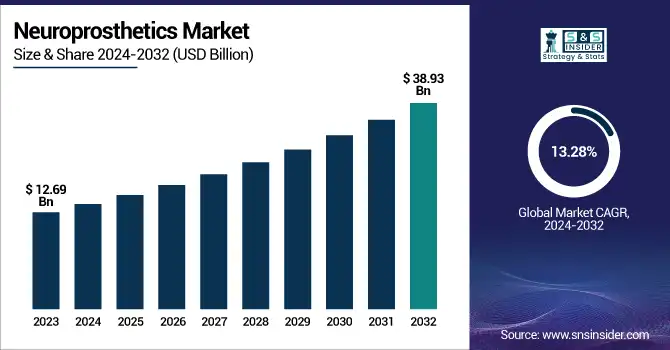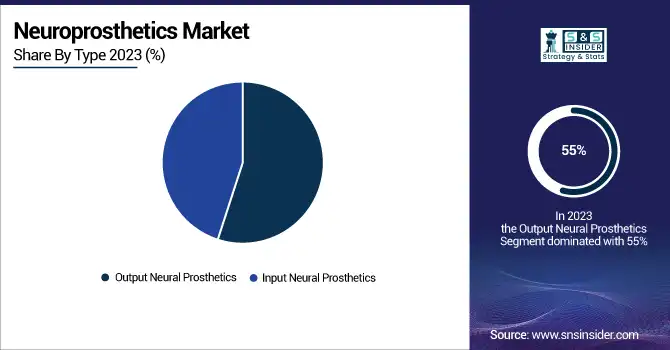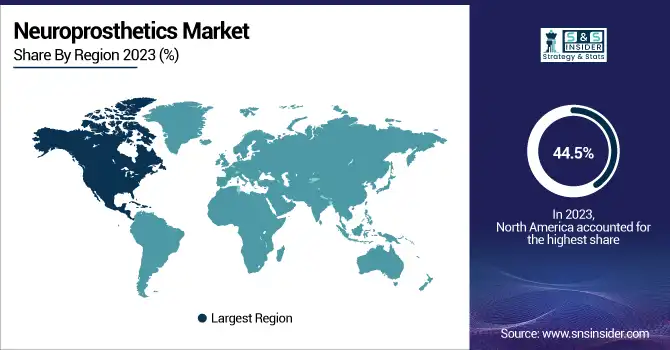Neuroprosthetics Market Overview:
The Neuroprosthetics Market size was valued at USD 12.69 billion in 2023 and is expected to reach USD 38.93 billion by 2032, growing at a CAGR of 13.28% over the forecast period 2024-2032.

To Get More Information on Neuroprosthetics Market - Request Sample Report
The neuroprosthetics market is experiencing substantial growth, driven by the increasing prevalence of neurological disorders and the demand for advanced therapeutic solutions. Neuroprosthetics are sophisticated devices that interface with the nervous system to restore or enhance neural functions. They are widely utilized for conditions such as Parkinson’s disease, epilepsy, chronic pain, hearing loss, and spinal cord injuries. According to the World Health Organization (WHO), over one-third of the global population is affected by neurological conditions, which are now the leading cause of disability worldwide. This rising burden has heightened the need for innovative interventions like neuroprosthetics.
Increased investment in research and development is another driving force. In 2023 alone, global funding for neuroprosthetic research exceeded USD 2 billion, focusing on expanding applications in memory restoration, sensory rehabilitation, and motor function recovery. For example, a study demonstrated the potential of memory prosthetics to improve recall in patients with Alzheimer’s disease by up to 37%.
Public awareness campaigns and healthcare initiatives are also contributing to market growth. Programs promoting the benefits of neuroprosthetics have encouraged adoption, particularly for non-invasive options like transcranial magnetic stimulation. Despite high costs and regulatory hurdles, collaborative efforts between governments, private enterprises, and research institutions are addressing these barriers.
Neuroprosthetics Market Dynamics
Drivers
-
The neuroprosthetics market is witnessing robust growth, fueled by the increasing emphasis on personalized healthcare.
Tailored neuroprosthetic devices, designed to meet individual patient needs, have become a cornerstone of precision medicine, significantly enhancing outcomes for individuals with neurological and sensory disorders. Additionally, the rising prevalence of lifestyle-related conditions, such as diabetes and obesity, has contributed to the growing demand for neuroprosthetics. These conditions often lead to complications like peripheral neuropathy, where devices such as functional electrical stimulators are increasingly utilized, thereby broadening their application spectrum. Advancements in material science and biocompatibility have further strengthened the market. The development of lightweight, flexible, and durable materials has improved the functionality and longevity of neuroprosthetic devices, making them more user-friendly and accessible.
Technological advancements are pivotal to the market’s expansion. For instance, brain-computer interfaces have enabled the creation of devices that allow paralyzed individuals to control robotic limbs. Cochlear implants, one of the earliest and most successful neuroprosthetic devices, have restored hearing for over 700,000 people globally. Additionally, spinal cord stimulators are widely used for chronic pain management, with studies showing up to a 50% reduction in pain levels in most patients. Emerging technologies such as artificial intelligence and machine learning enhance these devices' precision, adaptability, and effectiveness.
Restraints
-
High Costs, Regulatory Hurdles and Ethical Concerns are the major Challenges in the Neuroprosthetics Market
One of the foremost challenges is the high cost of neuroprosthetic devices and associated implantation procedures, making them unaffordable for many, especially in low- and middle-income regions. Limited insurance coverage for such advanced technologies further compounds the issue, restricting their accessibility. Another significant restraint is the stringent regulatory environment. As high-risk medical devices, neuroprosthetics undergo rigorous safety and efficacy evaluations, leading to prolonged approval processes and increased compliance costs. These factors can discourage smaller players from entering the market and slow the pace of innovation. Ethical concerns also present a challenge, particularly in neural interfacing. Issues related to patient privacy, data security, and potential misuse of brain-computer interface technologies have sparked debates that require careful navigation. Additionally, a lack of awareness among patients and healthcare providers about the benefits of neuroprosthetics, coupled with a shortage of trained professionals to perform these specialized procedures, further hampers adoption.
Neuroprosthetics Market Segmentation Analysis
By Type
Output neural prosthetics dominated the market in 2023, accounting for 55% of the revenue share. These devices are primarily used to restore motor functions, such as in patients with spinal cord injuries or limb amputations, making them indispensable in rehabilitation. Their extensive application in improving mobility and enhancing patient independence has propelled their dominance. Devices like cochlear implants and retinal prostheses further drive adoption, as they effectively restore sensory functions.
Input neural prosthetics is the fastest-growing segment, during the forecast period. These devices are gaining traction due to advancements in brain-machine interfaces and their potential to enable direct brain-to-device communication. Innovations in restoring cognitive functions and memory, alongside applications in treating neurodegenerative disorders like Alzheimer’s, contribute to their rapid growth.

By Technique
Deep brain stimulation held the largest share in 2023, accounting for 40% of the market revenue. Its effectiveness in treating a wide range of neurological disorders, including Parkinson’s disease, dystonia, and essential tremors, has established it as a leading technique. DBS is often preferred due to its ability to significantly reduce symptoms and improve the quality of life for patients with movement disorders.
Transcranial magnetic stimulation is the fastest-growing segment in 2024-2032. TMS has gained popularity for its non-invasive nature and efficacy in treating depression and other psychiatric disorders. Additionally, its expanding applications in neurological conditions, including migraines and post-stroke rehabilitation, drive its rapid adoption.
Neuroprosthetics Market Regional Insights
North America emerged as the leading region in the neuroprosthetics market in 2023, accounting for a 44.5% share due to its robust healthcare infrastructure, early adoption of advanced technologies, and a high prevalence of neurological disorders such as Parkinson’s disease and epilepsy. The presence of key players, with significant investments in research and development, has further strengthened the region’s dominance. Favorable reimbursement policies and increasing awareness about neuroprosthetic devices among healthcare providers and patients have also fueled market growth in this region.
Europe is the second-largest market, driven by rising cases of neurodegenerative diseases and supportive government initiatives promoting healthcare innovation. Countries like Germany, the UK, and France are at the forefront due to their well-established medical research facilities and growing investments in neurological care advancements.
The Asia-Pacific region is poised to be the fastest-growing market during the forecast period. This growth is attributed to the increasing prevalence of neurological disorders, a rapidly aging population, and expanding healthcare infrastructure in countries like China, India, and Japan. The rising disposable income and growing awareness about advanced medical devices are further accelerating adoption in this region.

Do You Need any Customization Research on Neuroprosthetics Market - Enquire Now
Key Players in the Neuroprosthetics Market
-
-
Product: Deep Brain Stimulation (DBS) Systems, Spinal Cord Stimulation (SCS) Systems, Functional Electrical Stimulation (FES) Systems.
-
Notable Products: Activa DBS Therapy, Intellis Spinal Cord Stimulator, and the RestoreSensor.
-
-
Cochlear Ltd.
-
Product: Cochlear Implants
-
Notable Products: Cochlear Nucleus Implants, Cochlear Baha Bone Conduction Implants.
-
-
Abbott Laboratories
-
Product: Neuromodulation Devices, Spinal Cord Stimulators
-
Notable Products: Proclaim XR Spinal Cord Stimulator, NeuroSphere Virtual Clinic for remote patient monitoring.
-
-
-
Product: Neuromodulation and Spinal Cord Stimulation (SCS) Devices
-
Notable Products: Spectra WaveWriter SCS System, Precision Spinal Cord Stimulation System.
-
-
LivaNova PLC
-
Product: Vagus Nerve Stimulation (VNS) Therapy
-
Notable Products: VNS Therapy System for treating epilepsy and depression.
-
-
Second Sight Medical Products, Inc.
-
Product: Retinal Prosthesis
-
Notable Products: Argus II Retinal Prosthesis System for vision restoration.
-
-
MED-EL
-
Product: Cochlear Implants and Hearing Prostheses
-
Notable Products: SYNCHRONY Cochlear Implant System, RONDO 2 Single-Unit Audio Processor.
-
-
Retina Implant AG
-
Product: Retinal Prosthesis
-
Notable Products: Alpha IMS Retinal Implant System for vision restoration in patients with retinitis pigmentosa.
-
-
Sonova
-
Product: Hearing Aids and Cochlear Implants
-
Notable Products: Phonak Audéo Paradise Hearing Aids, HiFocus Cochlear Implant.
-
-
NeuroPace
-
Product: Responsive Neurostimulation (RNS) System
-
Notable Products: RNS System for the treatment of epilepsy.
-
-
NDIE Medical, LLC
-
Product: Neurostimulation Devices
-
Notable Products: NDIE Brain Interface System for neuroprosthetics applications.
-
-
Nevro
-
Product: Spinal Cord Stimulation (SCS) Systems
-
Notable Products: Senza Spinal Cord Stimulation System for pain management.
-
-
St. Jude Medical, Inc. (now part of Abbott Laboratories)
-
Product: Neuromodulation and Cardiac Rhythm Management Devices
-
Notable Products: Brio Spinal Cord Stimulation System.
-
-
Retina Implant AG
-
Product: Retinal Prosthesis
-
Notable Products: Alpha IMS Retinal Implant System.
-
-
Nervo Corp.
-
Product: Neuromodulation Devices
-
Notable Products: NervoStim for pain management and neuromodulation.
-
-
BrainGate
-
Product: Brain-Computer Interface (BCI) System
-
Notable Products: BrainGate BCI for patients with severe motor disabilities
-
Recent Developments in the Neuroprosthetics Market
In June 2024, Sensars, a MedTech startup specializing in neuromodulation technology, secured USD 1.1 million in pre-seed funding from HTH, a health-focused VC firm. The investment supported the development of its innovative SENSY product, which provides advanced solutions for chronic pain relief.
In May 2023, Neurological surgery researcher Sergey Stavisky and his team were awarded USD 3.5 million in grants to advance their groundbreaking work in neuroprosthetics. The funding will support innovative research aimed at improving brain-machine interface technologies.
| Report Attributes | Details |
| Market Size in 2023 | USD 12.69 billion |
| Market Size by 2032 | USD 38.93 billion |
| CAGR | CAGR of 13.28% From 2024 to 2032 |
| Base Year | 2023 |
| Forecast Period | 2024-2032 |
| Historical Data | 2020-2022 |
| Report Scope & Coverage | Market Size, Segments Analysis, Competitive Landscape, Regional Analysis, DROC & SWOT Analysis, Forecast Outlook |
| Key Segments | • By Type [Output Neural Prosthetics (Motor Prosthetics, Cognitive Prosthetics), Input Neural Prosthetics (Cochlear Implant, Bionic Eye/ Retinal Implant)] • By Technique [Spinal Cord Stimulation, Deep Brain Stimulation, Vagus Nerve Stimulation, Sacral Nerve Stimulation, Transcranial Magnetic Stimulation] • By Application [Motor Neuron Disorders (Parkinson’s Disease, Epilepsy), Physiological Disorders (Auditory Processing Disorders, Cardiovascular Disorders, Kidney Disorders, Ophthalmic Disorders), Cognitive Disorders (Alzheimer's Disease, Paralysis)] |
| Regional Analysis/Coverage | North America (US, Canada, Mexico), Europe (Eastern Europe [Poland, Romania, Hungary, Turkey, Rest of Eastern Europe] Western Europe] Germany, France, UK, Italy, Spain, Netherlands, Switzerland, Austria, Rest of Western Europe]), Asia Pacific (China, India, Japan, South Korea, Vietnam, Singapore, Australia, Rest of Asia Pacific), Middle East & Africa (Middle East [UAE, Egypt, Saudi Arabia, Qatar, Rest of Middle East], Africa [Nigeria, South Africa, Rest of Africa], Latin America (Brazil, Argentina, Colombia, Rest of Latin America) |
| Company Profiles | Medtronic plc, Cochlear Ltd., Abbott Laboratories, Boston Scientific, LivaNova PLC, Second Sight Medical Products, Inc., MED-EL, Retina Implant AG, Sonova, NeuroPace, NDIE Medical, LLC, Nevro, St. Jude Medical, Inc., Nervo Corp., BrainGate |
| Key Drivers | • Neuroprosthetics Market Accelerates Growth Driven by Personalized Healthcare and Technological Advancements |
| Restraints | • High Costs, Regulatory Hurdles and Ethical Concerns are the major Challenges in the Neuroprosthetics Market |

